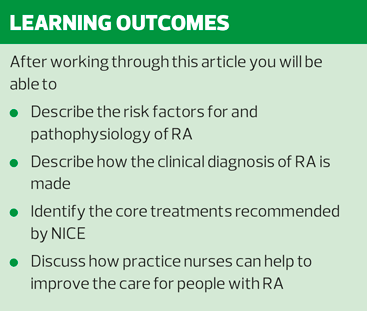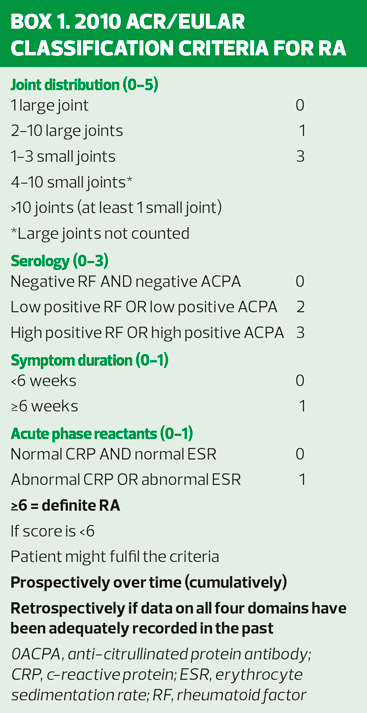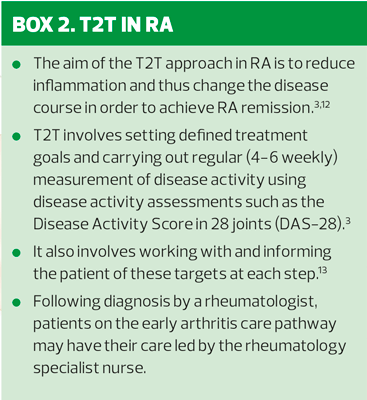Inflammatory arthritis: Part 3 Rheumatoid arthritis
Kate Gadsby
Kate Gadsby
RGN, BSc (hons), Dip MedSci NIP
Honorary Rheumatology Nurse Specialist, Royal Derby Hospital
Tricia Cornell
RGN, BSc (hons), NIP
Honorary Senior Rheumatology Practitioner, Poole Hospital NHS Trust
Declaration of Interest: Both authors work as Rheumatology Nurse Consultants for a pharmaceutical company but hold honorary contracts with the NHS. The pharmaceutical company has had no input into this article
In the last of our series on inflammatory arthritis, we present a step-by-step approach to a case study of rheumatoid arthritis (RA) and discuss its assessment, diagnosis and management, and the role of the general practice nurse in patient care
Rheumatoid arthritis (RA) is an inflammatory, systemic disease that typically involves the small joints of the hands and feet, often symmetrically. There are approximately 400,000 people with RA in the UK with women 2-4 times more commonly affected than men. It can develop at any age with a peak of incidence in both sexes after 70 years of age.5 In the UK, it is the second most common form of arthritis and the most common inflammatory joint disorder.8
The course of RA is variable and unpredictable. A significant number of patients will develop severe RA resulting in persistent pain and stiffness, progressive joint destruction, functional decline and premature mortality.6
MUSCULOSKELETAL HISTORY AND EXAMINATION
Competent history taking and examination of the affected joints are key to making an accurate diagnosis for a patient complaining of joint pain.9 Based on this history the key features which would raise suspicion of an inflammatory arthritis are:
- Swelling of the joints
- Early morning stiffness in the joints lasting more than 30 minutes
- A painful metacarpophalangeal (MCP) or metatarsophalangeal (MTP) squeeze.10
CASE STUDY – PART 1
Carol is a 53 year-old woman who works in administration at the local hospital. She attends your Well Woman clinic and complains that she has had tender, swollen fingers on both hands for the past 6 weeks as well as feeling fatigued and very stiff in the mornings – lasting up to two hours.
Diagnosis
The diagnosis of RA is based on medical history and clinical examination with the help of clinical investigations.6
Window of opportunity
During the initial weeks and months after the onset of symptoms there is a period of time known as the ‘window of opportunity’ for the early diagnosis and management of RA. It is crucial for patients to receive appropriate treatment in that time period to avoid long-term complications. Treatment early in the disease, even within the first 12 weeks for some, can prevent damage to joints and other organs, improve long-term function and increase the likelihood of achieving disease remission. Medical costs, disability and work limitations due to rheumatic conditions can all be reduced by early treatment.11
Specialist referral
NICE recommends that any person presenting with suspected inflammatory arthritis should be referred for specialist opinion as soon as possible to confirm the diagnosis and evaluate disease activity.5,6
Investigations
Investigations can be ordered by the GP but referral to a rheumatologist, in our opinion, needs to be made at the same time to avoid delay to diagnosis. Laboratory tests including ESR and CRP can be normal in the early stages of RA.5 However, while Rheumatoid Factor (RF) is positive in about 70% of patients with RA, a negative RF does not exclude a diagnosis of RA.4 NICE recommends the use of the anti-cyclic citrullinated peptide antibody (CCP) in RF-negative patients and when there is a need to inform decision-making about starting combination therapy.5
ACR/EULAR have published new criteria for the classification of early RA as x-rays rarely show changes early in the disease, and these criteria are generally used as base line measure.1 (Box 1)
Differential diagnoses
The main differential diagnoses of RA include other forms of inflammatory arthritis, such as:
- Psoriatic arthritis
- Reactive arthritis
- Post-viral arthritis
- Fibromyalgia
- Osteoarthritis
- Palindromic rheumatism
The role of the practice nurse
In our opinion, the practice nurse has a key role to identify the early signs and symptoms of inflammatory arthritis and to facilitate early referral to rheumatology. Advice on management of pain and swelling may be relevant at this stage as well as the use of analgesics, such as Non-Steroidal Anti-Inflammatory Drugs (NSAIDs), following assessment of risk factors and the potential use of PPIs.
CASE STUDY – PART 2
Carol is referred to the rheumatology department, diagnosed with RA and is prescribed oral methotrexate in combination with sulfasalazine, prednisone and analgesia with paracetamol/codeine. She is initially managed in secondary care by a multidisciplinary team (MDT), as recommended by NICE guidelines, until medication and monitoring are established and the disease is stable.5
The practice nurse plays a key role in identifying those people with early RA, ongoing disease assessments and monitoring RA treatment, especially when patients are on DMARDs such as methotrexate. Carol will be jointly managed in primary and secondary care.
Management
There is no known cure for this condition.11 The aim of RA treatment is to achieve remission or low-disease activity using a treat-to-target (T2T) strategy.3 (See Box 2: T2T in RA)
Treatment options in early RA include:
- Drug treatment including analgesia, NSAIDs, disease-modifying anti-rheumatic drugs (DMARDs), steroids, biologic disease-modifying anti-rheumatic drugs (bDMARDs), which include anti-TNFs and other biological therapies
- Physiotherapy, hydrotherapy, podiatry, occupational therapy and psychological support
- Life style advice including healthy diet, smoking cessation, exercise. 10
The DAS-28 is a composite score assessing disease activity in RA, comprising a joint count of 28 swollen and tender joints, inflammatory marker (Erythrocyte Sedimentation Rate or C-Reactive Protein) and a visual measure of the patient’s assessment of their general health using a visual analogue score (VAS). The score can be between 0 and 10. A score of over 5.1 denotes severe disease activity, and remission is under 2.6.14
DMARDs
recommends that people with newly diagnosed active RA are offered a combination of DMARDs (including methotrexate and at least one other DMARD, plus short-term glucocorticoids) as soon as possible as first-line treatment – ideally within 3 months of the onset of persistent symptoms.5
The role of the practice nurse
Patients on DMARDs should be regularly reviewed to monitor potential DMARDs side effects.5 Once the patient is established and stable on DMARDs the practice nurse should be involved in this monitoring by organising regular blood tests and completing a blood monitoring record. We know from experience that many departments use the National Patient Safety Agency (NPSA) methotrexate blood monitoring record as a way of communicating with the rheumatology team when the patient is reviewed.
Shared care
People with RA should have ongoing access to an MDT for regular assessment and treatment review including assessment of quality of life, the impact of the disease on their lives (e.g. pain, fatigue, mobility, ability to work, social or leisure activities, mood and impact on sexual relationships) and help to manage the condition.5 Once therapy is established, the practice nurse may be asked to take over the monitoring of the patient’s drug therapy following a local shared care guideline.
The rheumatology nurse should explain the risks and benefits of treatment options to people with RA and offer them verbal and written information about their condition in order to improve their understanding of RA and its management.5 However, we have found that the practice nurse may well be in a position to reinforce this information and act as a line of communication with the rheumatology department should the patient have any queries after initial consultation.
Self-management
Self-management represents a key part of RA management. The practice nurse may inform the patient of local self-management programmes available such as the Expert Patient Programme and reinforce the role of diet, exercise (especially low-impact sports like swimming and cycling) and dealing with fatigue as well as advice to stop smoking (if applicable).5
Associated conditions/Comorbidities
RA is associated with:
- Increased risk of cardiovascular disease.15
- Depression: over 10% of RA patients report symptoms.11
- Lung disease: 10% of people with RA develop serious lung complications over the course of their disease due to damage to the lung tissue.11
- Foot pathology: 90% of people with RA experience foot pathology, resulting in restricted mobility and pain.11
CASE STUDY – PART 3
Carol attends surgery 6 months after starting on methothrexate 20mg/week in combination with sulphasalazine, folic acid, prednisolone and analgesia. After the initial improvement, she was reviewed following 3 months of treatment. Her DAS28 has improved and the rheumatologist decides to reduce the prednisolone dose, with a view to stopping it, in order to reduce the risk of future osteoporosis.
Two months later, Carol presents with swollen, tender fingers and right foot. She feels very tired and unable to brush her hair or teeth. She has had to take time off work due to feeling so unwell.
The role of the practice nurse
Carol has an RA flare which is probably due to withdrawal of the steroid.
The practice nurse should advise Carol on how to manage the flare with rest, analgesia, and application of hot or cold pads to the affected joints.8 At this stage, liaison with the rheumatology department is advisable. As Carol’s symptoms didn’t settle within a couple of weeks with these measures and there was no evidence of infection, the rheumatology department recommended an intra-muscular injection of methylprednisolone and earlier review by the rheumatology team.
CASE STUDY – PART 4
Carol attends rheumatology for her early review a few weeks after the steroid injection. Her condition has flared again and her DAS28 is 6.79. She is unable to work, feels fatigued and is clearly depressed. She is reviewed by the consultant rheumatologist who suggests initiating biologic therapy.
Biological agents in RA
Biological agents have revolutionised the way RA is treated. NICE recommends the use of TNF-alpha inhibitors (adalimumab, etanercept, infliximab, certolizumab pegol, golimumab, tocilizumab or abatacept) as first line biologic options for the treatment of adults who have active severe RA with inadequate response to DMARDs including MTX. 16
The role of the practice nurse
Once Carol is established on biological therapy, the practice nurse may be involved in monitoring and screening for adverse events such as infections: the side effects profile of bDMARDs is similar across the therapeutic class, with a small increased risk of infections including a possible increased risk of food related infections. The practice nurse should be vigilant when assessing patients taking these medications to ensure that infections are treated swiftly to prevent further complications. They should also provide advice on stopping treatment in the case of any surgery depending on the biological agent’s SPC. The nurse should always liaise with other members of the MDT, including the patient’s rheumatologist, rheumatology specialist nurse and, of course, her GP.17,18
The practice nurse should provide advice on flu immunisation, in line with the immunisation schedule for at risk patients, and it is also recommended that patients who are prescribed DMARDs and or bDMARDs are given the pneumoccal vaccination.
CONCLUSION
RA is an autoimmune inflammatory arthritis that can lead to joint damage and disability if left untreated. Early diagnosis and treatment with DMARDs and biological agents have improved prognosis and outcomes. This case report illustrates the steps that need to be taken to make a timely diagnosis of RA. General practice nurses are well placed to identify the early signs of inflammatory arthritis, prompting early referral, as well as being involved in the ongoing management, monitoring and care of patients like Carol.
REFERENCES
1. Aletaha D, Neogi T, Silman AJ, et al. (2010) 2010 Rheumatoid arthritis classification criteria: an American College of Rheumatology/European League against Rheumatism collaborative initiative. Ann Rheum Dis 69:1580–88. http://www.eular.org/myUploadData/files/RA%20Class%20Slides%20ACR_Web.pdf
2. Sorenson J. Diagnostic delay in patients with rheumatoid arthritis, psoriatic arthritis and ankylosing spondylitis: results from the Danish nationwide DANBIO registry. Ann Rheum Dis 2015;74(3):e12
3. Smolen JS, Aletaha D, Bijlsma JW, et al. Treating rheumatoid arthritis to target: recommendations of an international task force Ann Rheum Dis 2010;69:631-37
4. Edwards J, Paskins Z, Hassell A. The approach to the patient presenting with multiple joint pain. ARUK Hands On. Reports on the Rheumatic Diseases Series 7. Autumn 2012. http://www.arthritisresearchuk.org/health-professionals-and-students/reports/hands-on/hands-on-autumn-2012.aspx
5. NICE CG79. Rheumatoid Arthritis – Management and Treatment in Adults, 2009. https://www.nice.org.uk/guidance/cg79/evidence/full-guideline-242191261
6. Scottish Intercollegiate Guidelines Network. Management of early rheumatoid arthritis (SIGN 123), 2011. http://sign.ac.uk/guidelines/fulltext/123/index.html
7. British Society for Rheumatology (2012) Top ten quality standards for RA. January. BSR
http://www.rheumatology.org.uk/includes/documents/cm_docs/2012/t/top_10_quality_standards_for_ra.pdf (accessed Jan 2017)
8. Arthritis Research UK (2011) Rheumatoid Arthritis. ARUK
9. Arthritis Research UK (2011) Clinical assessment of the musculoskeletal system: a guide for medical students and healthcare professionals. ARUK
10. Arthritis Research UK (2014). Inflammatory arthritis pathway. Step 1 – recognising symptoms before seeking help. http://www.arthritisresearchuk.org/arthritis-information/inflammatory-arthritis-pathway/step-one.aspx (Accessed January 2016)
11. BSR (2013) Simple tasks. Fast Facts. BSR http://rheumatology.org.uk/patient_information/simple_tasks/did_you_know.aspx (accessed Jan 2017)
12. Vermeer M, Kuper HH, Hoekstra M, et al. (2011) Implementation of a treat to target strategy in very early RA Arthritis Rheum 63: 2865-72
13. de Wit MP, Smolen JS,Gossec L, et al (2011) Treating rheumatoid arthritis to target: the patient version of the international recommendations. Ann Rheum Dis 70(6):891-5
14. Prevoo MLL. Arthritis Rheum 1995;38:44-48.
15. Solomon DH. Patterns for cardiovascular risk in rheumatoid arthritis. Ann Rheum Dis 2006;65;1608-1612
16. NICE TA375. Adalimumab, etanercept, infliximab,
certolizumab pegol, golimumab, tocilizumab and abatacept for rheumatoid arthritis not previously treated with DMARDs or after conventional DMARDs only have failed, 2016 https://www.nice.org.uk/guidance/ta375
17. Royal College of Nursing. Assessing, managing and monitoring biologic therapies for inflammatory arthritis, 2015. https://www.rcn.org.uk/professional-development/publications/pub-004744
18. Singh JA, Wells GA, Christensen R, et al. Adverse effects of biologics: a network meta-analysis and Cochrane overview. Cochrane Database of Systematic Reviews 2011, Issue 2. Art. No.: CD008794. DOI: 10.1002/14651858.CD008794.pub2.



